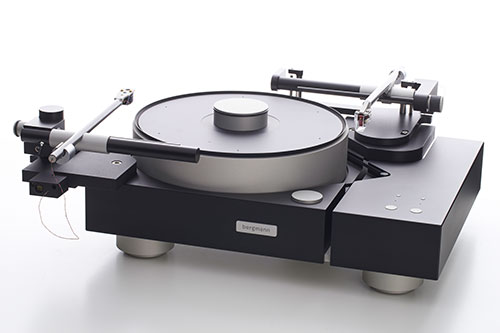No special test record is required to register that Sleipner and Co. elicit more room information than most competitors with well known recordings: The sound emanating from the speakers is happening even more naturally, imaginary rooms seem even more sweeping - I really have to pull myself together to avoid the obvious term "airier", otherwise it would have been too close to a corny pun about the bearing technology of the Sleipner. The tonearm and turntable convey the music completely without any spectacle or effects. The Sleipner keeps the sound of the record in the foreground - the turntable is far too reserved to impose its own stamp on the whole thing. However, the quality of the tonearm and turntable steered clear of reproducing any mechanically induced artifacts like few others - again a parallel to the Continuum. This freedom from noise not usually detectable on the record, is first produced during the playback operation. It enables the Sleipner to apparently extract more information from the grooves. Of course, other turntables also pick this up. However, they do mask tiny fine information with only the slightest bearing noise.
Briefly back to my initial thesis: Thanks to its very special platter bearing technology, the Sleipner keeps itself sonically out of the music more than almost any other turntable known to me. And this restraint is shared with its developer: There aren’t any showmen at work here.
STATEMENT
The Sleipner turntable/tonearm duo is, thanks to the airbearing technology, perfectly isolated from its surrounds and doesn’t mix any self-generated noise into the signal while playing a record. For that reason, it produces fine details and information tremendously well. Peak performance is reached in all other hi-fi criteria: The Bergmann Sleipner is one of two best turntables I've ever had in my listening room.-
Bergmann Audio Galder, Magne ST und Odin
Dass ich die Laufwerke und Tonarme von Bergmann Audio sehr schätze, dürfte hifistatement-Lesern nicht verborgen geblieben sein. Als sich dann in einem Gespräch mit Johnnie Bergmann und Werner Obst, seinem deutschen Vertrieb, herausstellte, dass es bisher keinen Vergleich zwischen Magne und Odin Tonarm gibt, war dieser Test beschlossene Sache. Grund für die hohe Wertschätzung der dänischen Analog-Spezialitäten ist vor allem die Beschäftigung mit dem Sleipner, der für mich auch heute noch neben dem Continuum Caliburn…20.12.2019 -
Transrotor Alto - mit drei Motoren
Vor wenigen Wochen hat mich der Transrotor Alto schon in seiner Grundausstattung mit einem Motor begeistert. Eine Aufwertung des Antriebes auf drei Motoren ist beim Alto leicht möglich. Was kann damit klanglich erreicht werden? Lohnt der Aufwand? Optisch ist der dreimotorige Alto auch mit nur einem Tonarmausleger schon ein mächtiges Musik-Monument. Die Aufstockung des Alto um zwei weitere Motoren erhöht auch seinen Bedarf an Aufstellfläche. Will man ihn in dieser Ausbaustufe nicht mit dem Tonarm-Ausleger…14.06.2019 -
Bergmann Audio Odin
Der Odin ist derzeit das Flaggschiff der luftgelagerten Bergmann-Audio-Tonarme. Firmenchef Johnnie Bergmann konstruierte ihn nicht speziell für einen seiner Plattenspieler, sondern als universell einsetzbaren Arm auch für Laufwerke anderer Hersteller. Dass ein Exemplar des Odin auf den Weg zu Hifistatement gebracht werden sollte, hatten Johnnie Bergmann, Werner Obst, der Bergmann-Analogtechnik schon beinahe seit der Markteinführung in Deutschland vertreibt, und ich bereits beim Besuch in der Fertigungsstätte im dänischen Hobro verabredet. Dann klappte es aber nicht…09.07.2018 -
Celebrating 10 Years of Bergmann Audio
Bergmann Audio is a company and not an individual—and that's a good thing. Otherwise it would not have been very charming to admit that I did not quite believe the news about their tenth anniversary. For me, the Danish manufacturer appeared to be much older, basically due to their technically independent designs seeming to have successfully established themselves in the analogue sector for decades. Well, Bergmann Audio is being internationally successful. The turntables and tonearms…06.07.2018 -
Transrotor Massimo mit SME V und Tamino
Transrotor baut nicht einfach nur hervorragend klingende Laufwerke, Jochen Räkes Kreationen sind immer auch Design-Objekte mit hoher Eigenständigkeit und perfekt bearbeiteten Oberflächen. Beim Massimo orientierte sich der Analog-Spezialist aus dem Bergischen Land an der Devise: form follows function – und schuf damit eines der attraktivsten Laufwerke überhaupt. Zumindest in den Augen des Autors. Lange Zeit schien sich das Thema Plattenspieler für mich erledigt zu haben: Ich bin mit meinem Laufwerk klanglich zufrieden, begeistere mich eher…13.04.2018 -
Zehn Jahre Bergmann Audio
Gut, dass Bergmann Audio eine Firma und keine Person ist. Denn andernfalls wäre es wenig charmant zuzugeben, dass ich die Nachricht vom zehnjährigen Jubiläum nicht recht glauben wollte: Ich hielt die Dänische Manufaktur für deutlich älter, nämlich dank ihrer technisch eigenständigen Konstruktionen für schon seit Jahrzehnten erfolgreich in der Analog-Szene etabliert. Nun, Bergmann Audio ist international erfolgreich, die Laufwerke und Tonarme zeichnen sich teils durch nirgendwo sonst zu findende, intelligente technische Details aus – nur…02.03.2018
© 2025 | HIFISTATEMENT | netmagazine | Alle Rechte vorbehalten | Impressum | Datenschutz

























 |
|





















































































